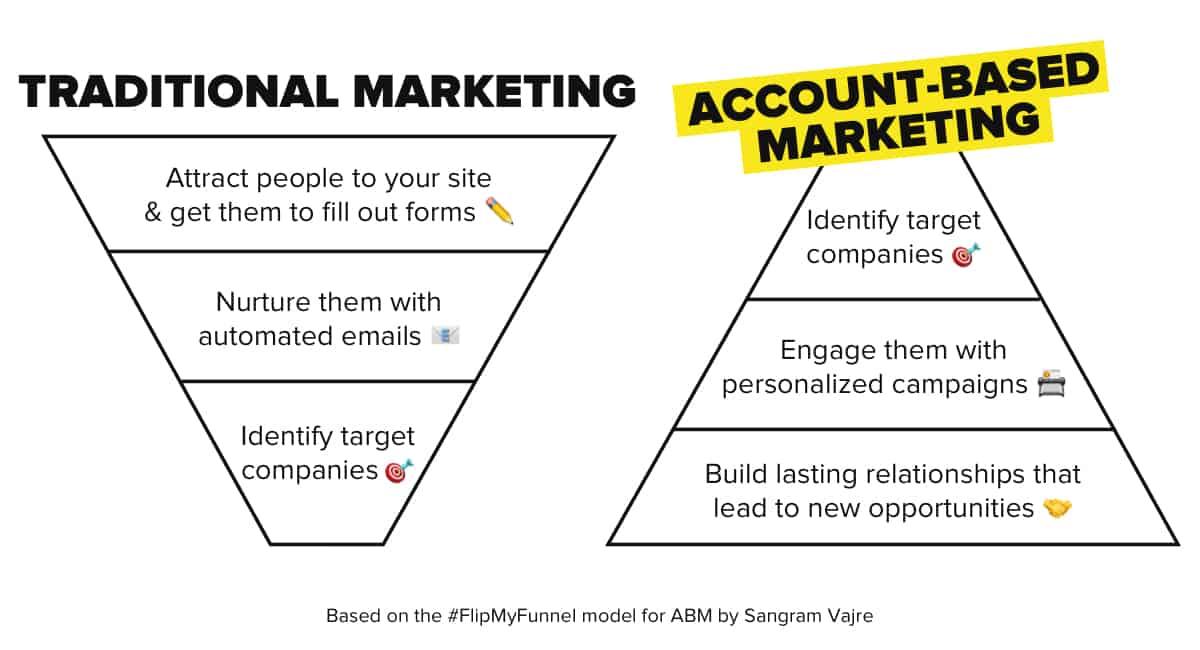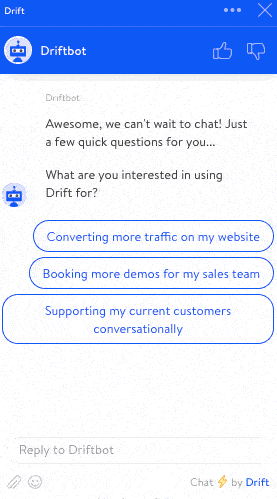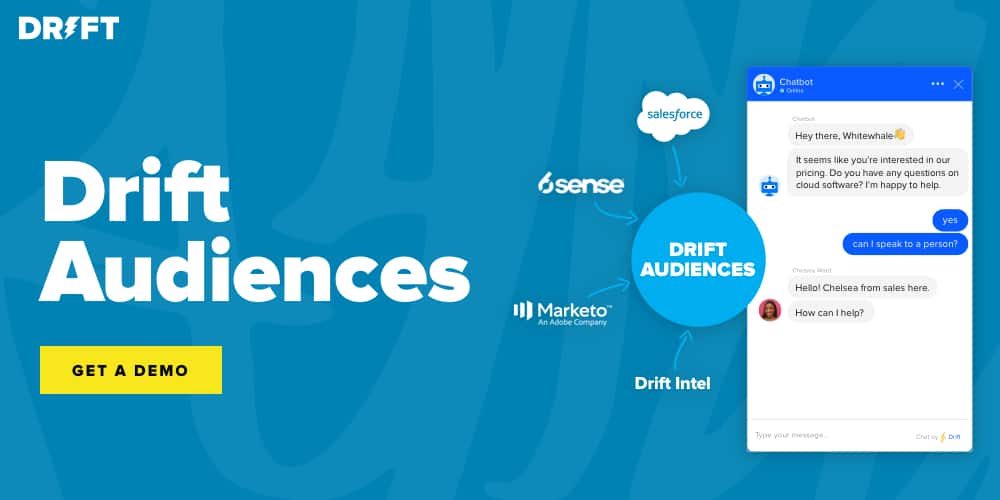
Customers are expecting more and more, especially when it comes to their experiences with a company.
No longer are customers deciding whether or not to buy a product based on its price alone. For the first time, a customer’s experience will overtake price as the key brand differentiator this year.
Now, here’s what companies are getting wrong right now when it comes to the experience their customers have. Instead of being customer-driven, companies have swayed and become data-driven. Looking at analytics, we forget to make a personal connection with our customers. This leaves their experience feeling cold and impersonal, which isn’t just bad for them – it’s bad for business.
It’s this connection that I hoped to create and automate at my current company, Ledger, and with my previous team at Finalcad, using Drift’s chatbot. The shift from automated chat to conversational marketing has meant companies can show, rather than tell, their brand story to their audience – automatically.
As a marketing executive, it’s my job to create that experience that our customers are looking for. Here’s what we’ve learned from introducing Drift into our tech stack to boost our ability to connect with our customers.
Chat tools are going through an intense revolution
I have been using chat tools for close to a decade now, and I feel confident in saying this – they’ve improved. A lot.
Chatbots are integrating into our tech more efficiently than ever. This may be because other tech, like CRMs and marketing automation, has realized that our customers (and the companies who are selling to them) work better together.
However, there is one part of the chatbot revolution that is completely changing the game – account-based marketing (ABM). For companies like Ledger and Finalcad who target enterprise and mid-market businesses, ABM has changed the way we connect and interact with our customers.

Building a funnel that capitalized on ABM used to mean channeling a mad scientist; plugging so many different things through API to make the workflow possible. With Driftbot, an ABM funnel is now possible for every marketing team, no matter how big or small.
The heart of ABM relies on engaging with customers on a personalized level, and hopefully, gives them a great experience that paves the way for a lasting relationship with your company. It turns out chatbots are perfect for ABM interactions with customers. Research by InsideSales says responding to customers in real-time can make all the difference when converting leads into customers.
The research also highlighted that the time that passes between the lead generation form submission and a sales rep reaching out has a direct impact on whether or not leads become customers.
And this is exactly what modern chatbots do – make immediate connections with your customers to not only boost their experience but make it easier to convert leads into customers.

Making instant contact with leads using ABM chatbots like Drift makes it easier to turn them into prospects.
So, it’s crystal clear that tech is catching up and matching up to the experience customers now expect. My next challenge? Making sure the other teams were on the same page.
Bridging the gap between the old tactics – and the new
I like to compare my approach to marketing to how we interact in everyday life.
Think about this. If you’re looking to catch up with a friend for a drink, you send them a message. If you need a ride home, you call an Uber.
So, using that same kind of tech – messaging – to build relationships with customers just makes sense to me. Merging old marketing tactics with new ways to boost customer experience is the best way to do that.
We’re in the midst of a once-in-a-lifetime shift when it comes to dealing with customers and tech. Chatbots are no longer cold and impersonal; they can take on the mannerisms of a sales rep, and create an end-user experience that bridges the gap between traditional marketing tactics and what today’s customers want – which is getting answers instantly.
I kept this in mind when I deployed Drift at Finalcad and Ledger into our teams of sales development representatives.
Their first reaction? Reluctance ?♂️
A chatbot taking over our first interactions with customers? It’ll never work, they thought. The notion was that our target customers and ideal buyers aren’t technically savvy, and chatbots aren’t going to work.
The truth is the sales and marketing industries are changing at a rapid pace. Tactics that worked even a decade ago have aged dramatically. And one aspect of the industry that both industry stalwarts and new sales reps can agree on is that it’s a people-based business; customers love to chat.
Chatbots that take the best of old tactics, like personalization, and merge them with the new, like speed and consistency. It turns out they’re the exact thing we needed in our sales and marketing toolkit. From the very first day we started to chat with customers using Drift, we had tons of meetings coming through our pipeline. And the team could still talk to leads using traditional methods, like picking up the phone, after the chatbot had done the legwork of getting that first meeting booked.
How to create a chatbot game plan
When I first joined the team at Finalcad, the lead numbers coming in from the website were weak. From 40,000 visits, the team was landing about 15 leads. So my very first mission was to change this, and I looked at chatbots as a way to strengthen the numbers.
My reasoning behind this was, as times were changing, it was clear chatbots were getting better and better in engaging with customers and starting conversations. However, once a lead came into a pipeline, there were still questions to be answered:
- Do those leads become opportunities?
- Are they being worked on by the sales guy and whatever pipeline does that generate?
- Down the line, what type of revenue does that generate?
After installing Drift, the numbers answered these questions. In the first quarter after adding a chatbot, Finalcad generated more pipeline leads than the entire sales team. The company leaned on ABM playbooks plugged by the chatbot to take the pressure off their SDRs in grabbing leads (which was essentially put on autopilot).
The work of 25 sales reps was now being replicated by the website’s Driftbot. The changes were a success. The numbers were proof.
Closing deals with a (very) small team
“If there’s a wall between sales and marketing, you’ve already lost the battle.”
True. But this phrase took on a whole new meaning when I joined Ledger and the sales and marketing team had no wall at all. It was just me, and I had to get smart with my budget. After all, I was building the campaigns, handling the chat, and closing deals by myself.
I needed a sidekick that helped with the workload, that didn’t cost as much as a traditional SDR. I leaned on the Driftbot to catch customers that landed on the site and book my calendar with qualified leads automatically.
In hindsight, this strategy worked to my advantage. Using the chatbot allowed me to compress our sales cycle, which was typically complicated and very long. There are lots of stakeholders, and because of the nature of our product, lengthy discussions about security and finance. Cutting the fat from our sales cycle by getting a lot of these early roadblocks cleared automatically using the Driftbot has cut our time to close by 50%. The deals are started with Drift, then closed using typical sales techniques.
I created this closing loop using two key strategies:
? Welcome messages: Website visitors are welcomed with messages based on regions which are adapted to different regions in different languages. The site primarily is in English, but we have a team in Asia, we have a team in South America, we have a team in Europe that addresses Italian and German markets. Using Drift, website visitors are now greeted using multiple different languages based on their IP location.
? Video playbooks: This ingredient was born out of marketing videos we had produced but not fully utilized. One was called The Voice of Our Customers that presented all the great customers and all the great work we had done with them. It had never been leveraged outside of our YouTube channel. So, we created a learning page, posted it there, and generated a quick extract of the video. These were then put into a playbook with a couple of links that would trigger the chat.
Looking back at these strategies, and the use of chatbots in general, it’s clear that they make sense. Using chatbots means we can always be there for our customers at the right time. They’re on our website engaging with us. Thanks to our Driftbot, it’s personable. And if they want to talk to us more, the Driftbot passes them off to the right person.
You can’t replace humans. But ABM is the next best thing ?
Chatbots can’t replace humans. And that’s a good thing.
Human to human conversations are still needed to close deals and create a better experience and relationship with our customers. However, one part of our sales and marketing process that can be improved is the timing we have when starting these interactions.
Our customer’s time is important, and we need to value it. Leveraging ABM through chatbots is a way we can merge all of the best bits of successful sales and marketing techniques (personalization, building lasting relationships, timeliness) while cutting out the other stuff that doesn’t add anything to our customer’s experience.
Your company has the chance to create memorable experiences thanks to the power of chatbots and conversational marketing. Are you going to take it?
Loic Jeanjean is a 360º Marketing executive who specializes in SaaS, Fintech, and B2B/B2B2C. He is currently the Head of Marketing at Ledger, where he deploys the global outbound and inbound marketing strategy.







